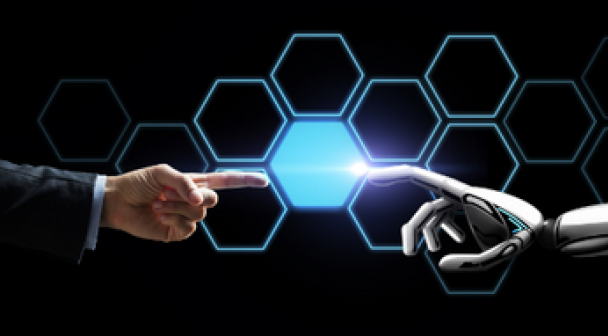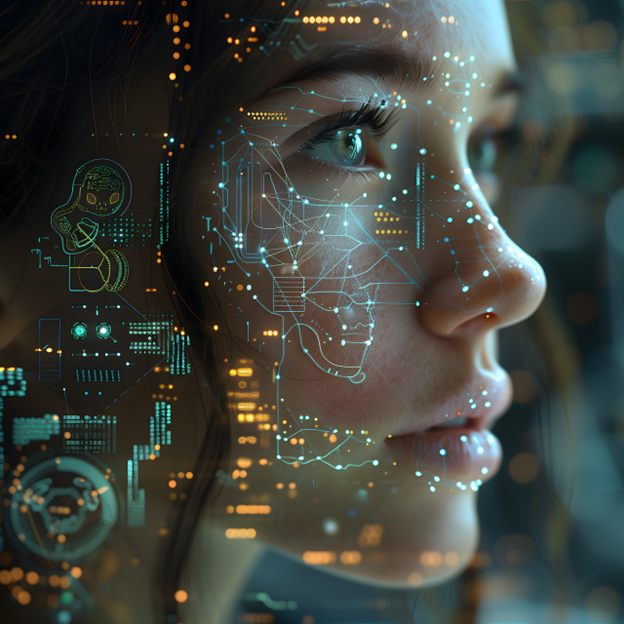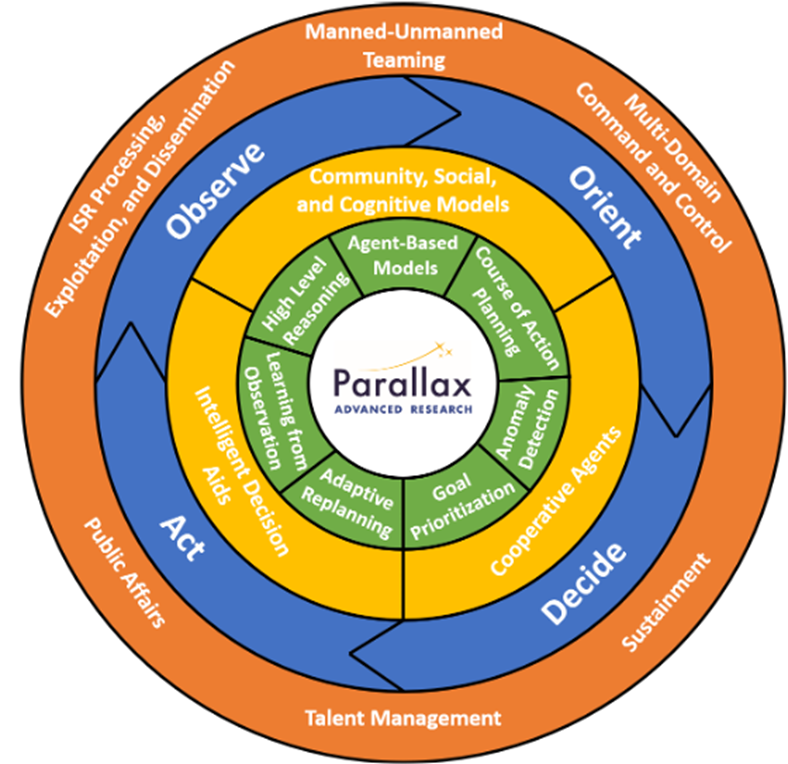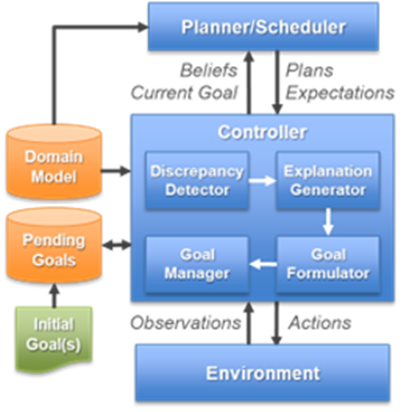Parallax is a leader in several facets of AI/ML. With our historical roots in human-machine teaming, we integrate cognitive psychology, neuroscience, human factors engineering, and cognitive systems engineering into our AI/ML research and applications. Our AI software and hardware teams create novel AI algorithms while working with both real-world and model and simulation data. Our meta-cognitive approaches mirror real-world cognition and lend themselves to explainability, robustness, and context awareness. These approaches are grounded in the problems we solve, such as airborne combat operations, contract data processing, infectious disease decision support, operational shaping of the battle space, safety-assured satellite docking, and counter-autonomy.
Human and Machine Cognitive Modeling

Human-machine teaming (HMT) encompasses a wide, multidisciplinary area of study that incorporates cognitive science, computer science, and human factors psychology to better understand how humans interact with technology to support common goals. Increasingly, intelligent AI agents and machines are becoming commonplace in workflows, requiring symbiotic collaboration between machines and human operators.
The goal of human-machine collaborations is to achieve better results than each agent alone. With the growing use of intelligent technology, understanding human and machine cognition is vital, given overlapping commonalities and cognitive differences leading to misunderstandings. HMT research emphasizes effective communication between humans and machines, providing transparency into the machine's cognitive processes. This fosters trust calibration. HMT applications span fields like aviation, robotics, logistics, chemical processing, and the power industry.
Parallax's HMT research includes:
- Human and Machine Cognitive Modeling
- Error Detection and Error Mitigation
- Establishing and Maintaining Trust


Applied HMT research spans a broad-spectrum of problem areas, including:
- Modeling human and AI cognitive processing
- Human-machine communication and interaction
- Human and machine error detection and mitigation
- Increasing task complexity and impact on cognitive load
- Dynamically calibrating trust in automation
- Distributed teaming and asymmetric information
- Improving teamwork competencies for humans and machines
Artificial Intelligence Development
Our custom models and software tackle complex problems using state-of-the-art techniques in cognitive modeling, reasoning systems, adaptive planning methods, evolutionary and memetic algorithms, natural language processing, computer vision, and deep, convolutional, reinforcement, and recurrent neural networks. Our AI group provides solutions in domains such as:
- Airborne systems
- Space systems
- Business systems
- Medical care and triage


Our process lies on the foundation of agile software development, which include:
- Development using the Scaled Agile Framework (SAFe 5.1)
- SCRUM principles and issue tracking
- Continuous integration/continuous deployment (CI/CD)
- Cloud-enabled and docked solutions capable of rapid deployment
Neuromorphic Computing

Neuromorphic computing is a revolutionary field inspired by the human biological brain's structure and function. It uses neural networks and synaptic-like elements in silicon circuits for fast, efficient, and adaptable computation. Compared to traditional computing platforms, this approach offers superior performance and low size, weight, and power (SWaP). Neuromorphic hardware and software, such as Spiking Neural Networks (SNNs), mimic the nonlinear dynamics of mammalian brains, transforming information into higher-dimensional states to derive outcomes. These systems excel in energy efficiency, high parallelism, robustness, and low latency processing, making them ideal for real-time applications in resource-constrained environments.
The computational demands of modern AI algorithms have surged, with some models consuming massive energy for training. In contrast, neuromorphic systems achieve high computational efficiency, like the human brain, which performs trillions of operations per second with minimal power consumption. This energy efficiency ensures their sustainability.
The AI Hardware Research Center of Excellence at Parallax Advanced Research leads in developing cutting-edge neuromorphic technologies, supporting applications in electronic warfare, ISR sensor processing, autonomous navigation, satellites, and advanced sensor fusion. This rapidly evolving field is projected to grow into an $8.58 billion market by 2030, reflecting its significant potential and impact on AI and technology sectors.
Emerging devices like memristors and phase change memory are enhancing neuromorphic architectures, emulating neural networks with improved efficiency and performance. Spiking Neural Networks (SNNs) are being developed for learning-enabled tasks, utilizing novel configurations that leverage sparsity and robustness to non-idealities. These advancements are crucial for applications such as cognitive computing, brain-computer interfaces, computer vision, signal processing, defense, autonomous robotics, and smart cities. Neuromorphic hardware systems, including Intel Loihi and IBM TrueNorth, are leading in the digital domain, driving efficient, adaptive learning systems for diverse, impactful uses.
Technical Problem Areas
- Benchmarking and Evaluation: It’s crucial that we press for enhanced performance metrics to fully understand and harness the power of neuromorphic computing.
- Experiments: Our relentless efforts are yielding significant advancements in SNN capabilities for specific tasks, instilling confidence in our progress.
- Improvements in Fabrication Technologies: We are developing new semiconductor fabrication technologies that must be optimized for the specific requirements of neuromorphic computing.
The computational demands of state-of-the-art AI algorithms have grown exponentially, with specific models now requiring 190,000 kWh for training. In contrast, our brains achieve over 240 trillion operations per second using 10-20 watts of power. Neuromorphic computing represents a revolutionary approach informed by the architecture of the biological brain, offering several advantages such as energy efficiency, high parallelism, robustness, and low latency processing. Unlike traditional computers, which process binary data sequentially, neuromorphic computers employ Spiking Neural Networks (SNNs), which learn with binary activations (spikes) and encode information over time. SNNs are often designed with power-efficient execution on specialized hardware to reduce on-chip data movements with sparse activations. For these reasons, neuromorphic systems have the potential to perform complex calculations faster, more efficiently, and on a smaller footprint than traditional computer architectures. These benefits are especially well-suited for mobile platforms that require real-time processing in resource-constrained environments. At the AI Hardware Research Center of Excellence at Parallax Advanced Research, we focus on developing cutting-edge neuromorphic software and hardware.
Technical Lead

Director, AI & Autonomy
Dr. Matthew Molineaux
Technical Lead

Director, AI Hardware Research
Dr. Steve Harbour
Technical Lead

Director, Cognitive Research
